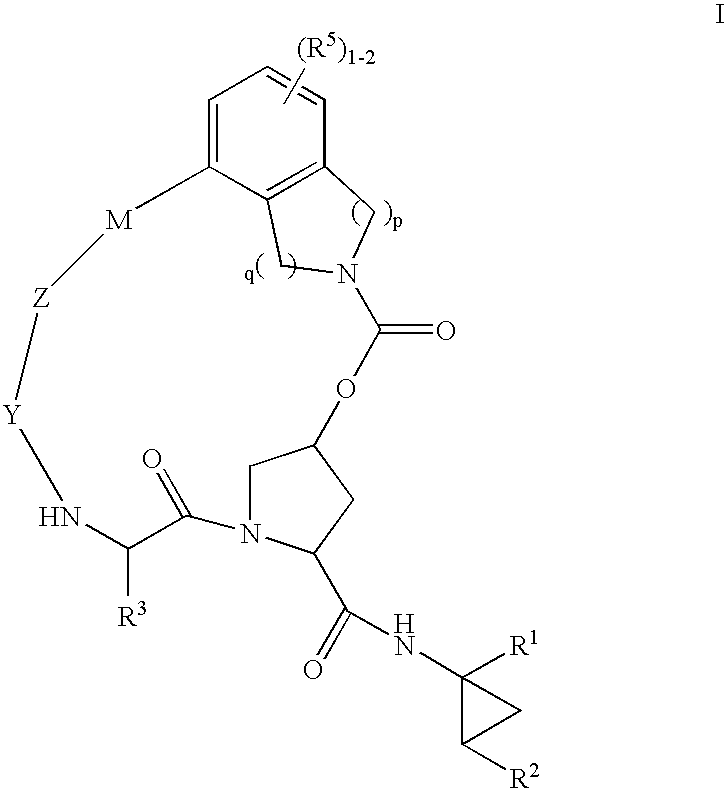HCV NS3 protease inhibitors
a protease inhibitor and hcv technology, applied in the direction of drug compositions, peptide/protein ingredients, peptide sources, etc., can solve the problems of limited clinical benefit, no established vaccine for hcv, and treatment of hcv infection
- Summary
- Abstract
- Description
- Claims
- Application Information
AI Technical Summary
Benefits of technology
Problems solved by technology
Method used
Image
Examples
example 1
(5R,7S, 10S)-10-Butyl-N-((1R,2S)-1-{[(cyclopropylsulfonyl)amino]carbonyl}-2-vinylcyclopropyl)-3,9,12-trioxo-1,6,7,9,10,11,12,14,15,16-decahydro-5H-2,22:5,8-dimethano-4,13,2,8,11-benzodioxatriazacycloicosine-7-carboxamide (III-1)
[0116]
Step 1: 4-Chloroisoindoline
[0117]
[0118]A mixture of 3-chlorophthalic acid anhydride (9 g, 49.2 mmol) and formamide (100 mL) was heated to 125 ° C. and stirred for 3 h. Water (300 mL) was then added and the mixture was cooled to room temperature. The mixture was filtered and the resulting white solid was washed with water and dried to give 4-chloro-1H-isoindole-1,3(2H)-dione (7.7 g, 86% yield).
[0119]To solid 4-chloro-1H-isoindole-1,3(2H)-dione (4.0 g, 22.0 mmol) was added borane-THF complex (1 M / THF, 88.1 mL, 88.1 mmol) dropwise with stirring. When the addition was complete, the reaction mixture was heated to reflux (80 ° C.) and stirred for 6 h. The reaction mixture was then cooled to 0° C., methanol (2.8 mL, 88.1 mmol) was carefully added dropwise and ...
example 2
(5R,7S,10S)-10-tert-Butyl-N-((1R,2S)-1-{[(cyclopropylsulfonyl)amino]carbonyl}-2-vinylcyclopropyl)-3,9,12-trioxo-1,6,7,9,10,11,12,14,15,16-decahydro-5H-2,22:5,8-dimethano-4,13,2,8,11-benzodioxatriazacycloicosine-7-carboxamide (III-2)
[0131]
[0132]EXAMPLE 2 was prepared according to the procedure used for EXAMPLE 1 except that 3-methyl-N-[(pent-4-enyloxy)carbonyl]-L-valine (prepared according to the procedure below) was used in place of N-[(pent-4-en-1-yloxy)carbonyl]-L-norleucine in Step 4. 1H NMR (500 MHz, ppm, CDCl3) δ 9.90 (s, 1 H), 7.28 (m, 2 H), 7.13 (m, 2 H), 6.31 (d, J=15.9 Hz, 1 H), 5.74 (m, 1 H), 5.45 (m, 2 H), 5.27 (d, 1 H), 5.16 (d, 1 H), 4.77-4.66 (m, 3 H), 4.55 (d, 1 H), 4.48 (t, 1 H), 4.41-4.35 (m, 2 H), 4.27 (m, 1 H), 3.93 (m, 1 H), 3.74 (dd, 1 H), 2.93 (m, 1 H), 2.45 (d, 2 H), 2.32 (m, 2 H), 2.10-1.95 (m, 2 H), 1.74 (m, 1 H), 1.47 (m, 1 H), 1.37 (m, 2 H), 1.07 (s, 9 H) ppm. LRMS (ESI) m / z 712 [(M+H)+; calcd for C35H46N5O9S: 712].
example 3
(5R,7S,10S)-10-tert-Butyl-N-((1R,2S)-1-{[(cyclopropylsulfonyl)amino]carbonyl}-2-vinylcyclopropyl-15,15-dimethyl-3,9,12-trioxo-1,6,7,9,10,11,12,14,15,16-decahydro-5H-2,22:5,8-dimethano-4,13,2,8,11-benzodioxatriazacycloicosine-7-carboxamide (III-8)
[0133]
Step 1: 1-Bromo-2,3-bis(bromomethyl)benzene
[0134]
[0135]A suspension of 3-bromo-o-xylene (196 g, 1.06 mol), N-bromosuccinimide (377 g, 2.15 mol) and benzoyl peroxide (0.26 g, 1.0 mmol) in carbon tetrachloride (1800 mL) was heated to reflux under nitrogen for 15 h. The contents of the reaction flask were cooled, filtered, and the filtrate evaporated. Distilled crude material under high vacuum. Major fractions distilled between 88° C. and 152° C. Recovered 108 g pure material. Recovered 182 g slightly crude material which could be used in the following reaction. 1H NMR (CDCl3) δ (ppm) 7.56 (d, J=8.0 Hz, 1 H), 7.31 (d, J=8.0 Hz, 1 H), 7.26 (s, 1 H), 7.16 (t, J=8.0 Hz, 1 H), 4.84 (s, 2 H), 4.64 (s, 2 H).
Step 2: 2-Benzyl-4-bromoisoindoline
[0...
PUM
| Property | Measurement | Unit |
|---|---|---|
| temperature | aaaaa | aaaaa |
| temperature | aaaaa | aaaaa |
| temperature | aaaaa | aaaaa |
Abstract
Description
Claims
Application Information
 Login to View More
Login to View More - R&D
- Intellectual Property
- Life Sciences
- Materials
- Tech Scout
- Unparalleled Data Quality
- Higher Quality Content
- 60% Fewer Hallucinations
Browse by: Latest US Patents, China's latest patents, Technical Efficacy Thesaurus, Application Domain, Technology Topic, Popular Technical Reports.
© 2025 PatSnap. All rights reserved.Legal|Privacy policy|Modern Slavery Act Transparency Statement|Sitemap|About US| Contact US: help@patsnap.com



